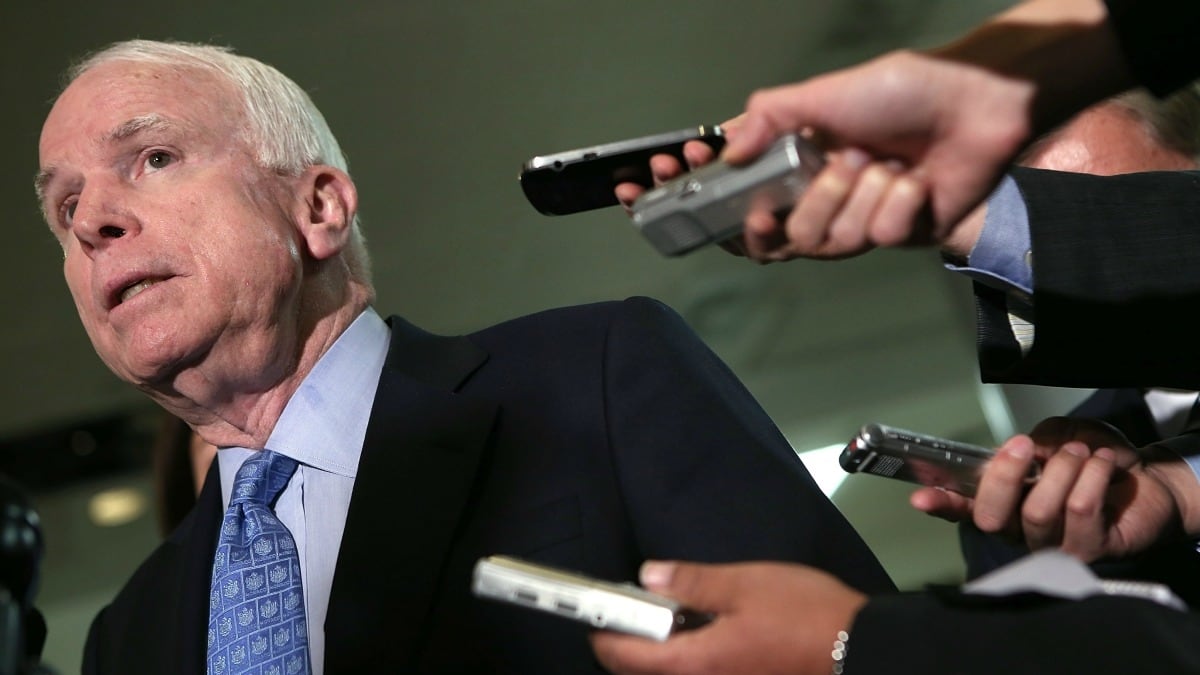Every single way the U.S. can possibly intervene in Syria has its own pitfalls. The cliché has almost never been more true: there are no good options. The full range of interventions being discussed—from a no-fly zone to arming rebels to securing Syrian chemical weapons—each holds perilous risks. And no end-game for any sort of involvement has yet been outlined by proponents of American action. While some advocates of intervention are frank about these risks, they see work-arounds; some of the most prominent hawks, though, won't even take public stock of the dangers.

Take John McCain. McCain literally phoned it in to a CNN panel discussion this week where he acknowledged virtually no potential drawbacks, and minimized any risks of intervention. The commentator Andrew Sullivan harried McCain about the risks of war, recalling Iraq. But McCain flatly dismissed him, pointing instead to testimony by top military brass "that we can take out Syrian air on the ground with cruise missiles, and we can defend a safe area with Patriot missiles and other weapons." Citing the brass is fine on a no-fly zone, but when it came to the Pentagon's estimation that tens of thousands of ground troops would be needed for securing chemical weapons sites, McCain was again dismissive: "By the way, 75,000 is a gross exaggeration as the Pentagon tends to do"—though McCain didn't offer any lesser estimate, which would have been at odds with his avowed position of having no troops in Syria. Sullivan again, and rightly, raised Iraq, where McCain went along with the Bush administration in bucking the Pentagon's recommendations for force size and failed to articulate any risks of the war going in; it was supposed to be a cakewalk. Sullivan pointed out that we all know how that movie ended.
Nonetheless, pressing for a no-fly zone is not an entirely unreasonable position. The most clear case for a no-fly zone was made by former Marine aviator Scott Cooper in the Washington Post. Cooper didn't shy away from enumerating risks: robust Syrian air defense systems; pilots potentially being shot down; the lack of an end-game strategy; and the "slippery slope of escalated military involvement." But he recounted the narrow aims of a no-fly zone: "Its purpose is not to resolve the conflict but to prevent escalation, protect innocents and provide leverage to negotiations," Cooper wrote. "In essence, a no-fly zone takes away a single tool of violence—the use of aviation—possessed by the oppressor." Cooper pointed to Bosnia as an example of a successful no-fly zone. But here he and McCain come up short.
Michael O'Hanlon, another advocate of a no-fly zone, frankly acknowledged what this will mean in his own pro-intervention op-ed using the Bosnia example: "Yes, this plan does imply a number of U.S. peacekeepers on the ground, perhaps comparable in number to the 20,000 who began the job in Bosnia in 1995." You'll quickly note that O'Hanlon's number is well shy of the 75,000 troops recommended by the Pentagon to secure chemical weapons, but it's still a helpful reminder. It's also a harrowing proposition: putting fewer troops on the ground than necessary to secure chemical weapons might leave them subject to precisely a chemical weapons attack.
Putting a lid on Syria's chemical weapons is a dangerous and complicated business. That's why it's so mystifying that McCain dismissed the idea of ground troops altogether—he knows it looks bad for his case—but simultaneously said that chemical weapons must be secured: "I think it has to be an international effort," McCain told CNN. A U.N. role will be tough to achieve because Russia seems certain to block any action. That leaves NATO, or the Arab League. Will NATO countries want to put boots on the ground, something they avoided in Libya? Does the Arab League have the will, or even the capability? What's more, Eli Lake reported yesterday that the U.S. isn't even sure it knows where all the weapons are.
The Libya example is in many ways illuminating: it was a classic case of the "slippery slope of escalated military involvement"—otherwise known as mission creep. The narrowly defined U.N. no-fly zone quickly morphed into offensive military airstrikes aimed at bringing down the regime. Qatar's arms shipments ended up in the hands of extremists just as their arms to Syria were, until recently when the West—namely, the C.I.A.—stepped in to facilitate vetting. ("They say they're able to get the humanitarian aid to the right people but they can't get the arms to the right people," McCain said on CNN. But of course the right targets of humanitarian aid are just people in general, extremist or otherwise, so long as they don't hoard the supplies.)
These complications, elided by intervention advocates, are exactly what critics of intervention point to as the oversimplification of Syria: "Syria is an immensely complex sectarian civil war," Sullivan wrote in his post. "It’s their country and we involve ourselves at our peril. Once we directly intervene in defense of one nebulous faction, we will deeply alienate another. We will be injecting the U.S. into a brutal religious and ethnic civil war." Wanting to end the slaughter of Syrian civilians is a noble aim; the situation is a humanitarian catastrophe. But the moral imperative to protect civilians cannot be regarded in a vacuum, independent of the imperative to foresee a way out of the war for America. The Iraq analogies aren't perfect, but the U.S. must guard against repeating the mistakes made there—namely, wishing away the complexities. After all, our intervention in Iraq was its own moral catastrophe.





